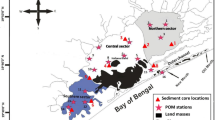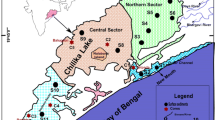Abstract
The proportion of blue carbon contribution by benthic fauna with regard to climate change issue is a relevant topic recent times. The present study is focusing on the carbon potential and blue carbon contribution of meiobenthic nematodes in the intermediate zone of Arctic Kongsfjord during 2015–2017 and the study is the first of its kind from this region. Foraminifera and Nematoda were the dominant fauna in 2015; whereas it was Foraminifera in 2016 and Tintinnida and Nematoda in 2017. Significant difference was noticed in the community structure of meiofauna in this three consecutive years. Twenty six nematodes were identified from the intermediate zone and their individual carbon potential and total blue carbon during the above-mentioned period is estimated. Parasphaerolaimus paradoxus (7.14 ± 0.05 μg/mg) recorded the highest carbon potential and the lowest value was recorded in Terschellingia longicaudata (0.11 ± 0.3 μg/mg). The sediment factors such as sediment granulometric composition, salinity, pH, Eh and total organic carbon (TOC) were the leading factors influencing the meiofaunal distribution as well as the distribution of nematodes based on carbon potential in the intermediate zone. Investigation of blue carbon deposition by nematodes turned out to be relevant in mitigating the climatic change as the fjord has a tranquil nature.











Similar content being viewed by others
References
Abebe E, Andrassy I and Traunspurger W 2006 Freshwater nematodes ecology and taxonomy; CAB International Wallingford Oxfordshire OX10 8DE, UK.
Adao H, Alves A S, Patrício J, Neto J M, Costa M J and Marques J C 2009 Spatial distribution of subtidal Nematoda communities along the salinity gradient in southern European estuaries; Acta Oecologica 35(2) 287–300.
Andrassy I 1956 The determination of volume and weight of nematodes; Acta Zool. Acad. Sci. Hung 2 1–15.
Aswathy N K, Athira A T, Krishnapriya P P, Jima M, Vijay A, Bijoy Nandan S and Krishnan K P 2017 Functional trait analysis of meiobenthic nematodes in the Arctic Kongsfjord; J. Aqua. Bio. Fis. 5 65–78.
Austen M C, Warwick R M and Rosado M C 1989 Meiobenthic and macrobenthic structure along a putative pollution gradient in southern Portugal; Mar. Pollut. Bull. 20 398–405.
Barnes D A K, Sands C J, Richardson A and Smith N 2019 Extremes in benthic ecosystem services: Blue carbon natural capital shallower than 1000 m in isolated, small, and Young Ascension Island’s EEZ; Front. Mar. Sci. 6(663) 1–12.
Blomqvist S 1991 Quantitative sampling of soft-bottom sediments problems and solutions; Mar. Ecol. Prog. Ser. 72 295–304.
Clarke K R and Gorley R N 2006 Primer ver. 6.1.6 user manual/tutorial Primer-E; Plymouth, UK.
Coull B C 1988 Ecology of marine meiofauna; In: Introduction to the Study of Meiofauna (eds) Higgins R P and Thiel H, Smithsonian Institution Press, London, pp. 19–38.
de Maeseneer J and D’ Herde J 1963 Métodes utilisées pour l’étude des anguillules libres du sol; Revue De Agriculture Bureaux 16 441–447.
Elverhøi A, Lønne Ø and Seland R 1983 Glaciomarine sedimentation in a modern fjord environment, Spitsbergen; Polar Res. 1(2) 127–150.
Fenchel T 1970 Studies on the decomposition of organic detritus derived from the turtle grass Thalassia testudinum; Limnol. Oceanogr. 15 14–20.
Findlay S and Tenore K R 1982 Effect of a free-living marine nematode (Diplolaimella chitwoodi) on detrital carbon mineralization; Mar. Ecol. Prog. Ser. 8 161–166.
Folk R L 1974 The Petrology of Sedimentary Rocks; Tx, Hemphill Publishing Co., Austin, 182p.
Gabrielsen G W, Hop H, Hübner C, Kallenborn R, Weslawski J M and Wiencke C (eds) 2009 The Kongsfjorden System – a flagship programme for Ny-Ålesund; A concluding document from Workshop 28–31 March, 2008, Norwegian Polar Institute, Polar Environmental Centre, NO-9296, Tromsø.
Giere O 2009 Meiobenthology – The microscopic motile fauna of aquatic sediments; 2nd edn. Springer Verlag, Heidelberg.
Gooday A J 2003 Benthic foraminifera (Protista) as tools in deep-water palaeoceanography: Environmental influences on faunal characteristics; In: Advances in Marine Biology (eds) Southward A J, Tyler P A, Young C M and Fuiman L A, London, UK, Academic Press, 46 3–90.
Gordon D, Murray B C, Pendleton L and Victor B 2011 Financing options for blue carbon: Opportunities and lessons from the REDD+ Experience. Report NI R 11-11, Nicholas Institute for Environmental Policy Solutions, Duke University, Durham Duke.
Greiser N and Faubel A 1988 Biotic factors; In: Introduction to the Study of Meiofauna (eds) Higgins R P et al., pp. 79–114.
Guilini K, Soltwedel T, van Oevelen D and Vanreusel A 2011 Deep-sea nematodes actively colonise sediments, irrespective of the presence of a pulse of organic matter; Results from an in-situ experiment; PLOS ONE 6(4).
Higgins R P and Thiel H 1988 Introduction to the study of meiofauna; Smithsonian Inst. Press, Washington, D.C.
Hop H, Pearson T, Hegseth E N, Kovacs K M, Wiencke C, Kwasniewski S and Lydersen C 2002 The marine ecosystem of Kongsfjorden, Svalbard; Polar Res. 21(1) 167–208.
Jensen P 1978 Revision of microlaimidae, erection of Paramicrolaimus (Nematoda, Desmodorida); Zool. Scr. 7 159–173.
Jensen P 1979 Revision of Comesomatidae (Nematoda); Zool. Scr. 8 81–103.
Jensen P 1984 Measuring carbon content in nematodes, Helgolander; Meeresunters 38 83–86.
Jensen P 1987 Feeding ecology of free-living aquatic nematodes; Mar. Ecol. Prog. Ser. 35 187–196.
Klages M, Boetius A, Christensen J P, Deubel H, Piepenburg D, Schewe I and Soltwedel T 2004 The benthos of Arctic seas and its role for the organic carbon cycle at the seafloor; In: The organic carbon cycle in the Arctic Ocean; Springer, Berlin, Heidelberg, pp. 139–167.
Kotwicki L, Szymelfenig M, De Troch M and Zajaczkowski M 2004 Distribution of meiofauna in Kongsfjorden, Spitsbergen; Polar Biol. 27 661–669.
Krishnapriya P P, Minu M, Hershey R, Nandan S B and Krishnan K P 2019 Inter fjord variations as a key contributor in the meiobenthic faunal distribution in the Arctic Kongsfjord, Svalbard; Reg. Stud. Mar. Sci. 32 100817.
Krishnapriya P P, Minu M and Bijoy Nandan S 2018 Composition and distribution of meiobenthos in Arctic Kongsfjord (Svalbard) with reference to carbon potential of selected fauna; Indian J. Mar. Sci. 47(03) 613–622.
Li J and Vincx M 1993 The temporal variation of intertidal nematodes in the Westerschelde I. The importance of an estuarine gradient; Neth. J. Aquat. Ecol. 27(2–4) 319–326.
Loeng H 1991 Features of the physical oceanographic conditions of the Barents Sea; Polar Res. 10(1) 5–18.
MacGilchrist G A, Garabato A N, Tsubouchi T, Bacon S, Torres-Valdés S and Azetsu-Scott K 2014 The Arctic Ocean carbon sink; Deep-Sea Res; Part I: Oceanogr. Res. Papers 86 39–55.
Moens T, Luyten C, Middelburg J J, Herman P M J and Vincx M 2002 Tracing organic matter sources of estuarine tidal flat nematodes with stable carbon isotopes; Mar. Ecol. Prog. Ser. 234 127–137.
Moens T, Vanhove S, De Mesel I, Kelemen B, Janssens T, Dewicke A and Vanreusel A 2007 Carbon sources of Antarctic nematodes as revealed by natural carbon isotope ratios and a pulse-chase experiment; Polar Biol. 31 1–13.
Murray J W 2006 Ecology and applications of benthic foraminifera; Cambridge University Press.
Nellemann C, Corcoran E, Duarte C M, Valdes L, DeYoung C, Fonseca L and Grimsditch G (eds) 2009 Blue Carbon – A rapid response assessment; United Nations Environment Programme, GRID-Arendal.
Pfannkuche O and Thiel H 1988 Introduction to the study of meiofauna; Smithsonian Institution Press, Washington, D.C.
Platt H M and Warwick R M 1983 Free-living marine nematodes, Part I. British Enoplids; Cambridge University Press.
Platt H M and Warwick R M 1988 Free-living marine nematodes, Part II. British Chromadorids; Cambridge University Press.
Platt H M and Warwick R M 1998 Free-living marine nematodes, Part III. British Monhysterids; Cambridge University Press.
Salonen K A 1979 Versatile method for the rapid and accurate determination of carbon by high temperature combustion; Limnol. Oceanogr. 24 177–183.
Schlesinger H W 1999 Carbon sequestration in soils; Science 25 284.
Schmidt-Rhaesa A (ed.) 2014 Handbook of Zoology. Gastrotricha, Cycloneuralia, Gnathifera; Volume 2, Nematoda; de Gruyter.
Schratzberger M, Rees H L and Boyd S E 2000 Effects of simulated deposition of dredged material on structure of nematode assemblages-the role of burial; Mar. Biol. 136 519–530.
Schratzberger M and Warwick R M 1999 Differential effects of various types of disturbances on the structure of nematode assemblages, an experimental approach; Mar. Ecol. Prog. Ser. 181 227–236.
Seinhorst W 1959 A rapid method for the transfer of nematodes from fixative to anhydrous glycerine; Nematologica 4 67–69.
Somerfield P J, Cochrane S J, Dahle S and Pearson T H 2006 Free-living nematodes and macrobenthos in a high-latitude glacial fjord; J. Exp. Mar. Biol. Ecol. 330 284–296.
Svendsen H, Beszczynska-Møller A, Hagen J O, Lefauconnier B, Tverberg V, Gerland S and Azzolini R 2002 The physical environment of Kongsfjorden–Krossfjorden, an Arctic fjord system in Svalbard; Polar Res. 21(1) 133–166.
Thomasy H 2020 The Arctic Ocean may not be a reliable carbon sink; EoS 101.
Thompson K, Miller K, Johnston P and Santillo D 2017 Greenpeace Research Laboratories Technical Report (Review); Greenpeace Research Laboratories, Exeter, UK.
Tietjen J H 1980 Microbial–meiofaunal interrelationships: A review; Microbiology 23(3) 335–338.
Urban-Malinga B, Wiktor J, Jabłońska A and Moens T 2005 Intertidal meiofauna of a high-latitude glacial Arctic fjord (Kongsfjorden, Svalbard) with emphasis on the structure of free-living nematode communities; Polar Biol. 28(12) 940–950.
Vanreusel A 1990 Ecology of the free-living marine nematodes from Voordelta (Southern Bight of the North Sea) I. Species composition and structure of nematode communities; Cahiers de Biologie Marine 31 439–462.
Wang H W and McSorley R 2005 Effects of Soil Ecosystem Management on Nematode Pests, Nutrient Cycling, and Plant Health; APS Net Features 10 1094.
Warwick R M, Platt H M, Clarke K R, Agard J and Gobin J 1990 Analysis of macrobenthic and meiobenthic community structure in relation to pollution and disturbance in Hamilton Harbour, Bermuda; J. Exp. Mar. Biol. Ecol. 138 119–142.
Wiencke C and Hop H 2016 Ecosystem Kongsfjorden: New views after more than a decade of research; Polar Biol. 39 1679–1687.
Wilson M J and Duarte T K 2009 Nematodes – As environmental indicators; CABI Head Office, Nosworthy Way, Wallingford, Oxfordshire OX10 8DE UK.
Wlodarska-Kowalczuk M and Pearson T H 2004 Soft-bottom macrobenthic faunal associations and factors affecting species distributions in an Arctic glacial fjord (Kongsfjord, Spitsbergen); Polar Biol. 27 155–167.
Wlodarska-Kowalczuk M, Gorska B, Deja K and Morata N 2016 Do benthic meiofaunal and macrofaunal communities respond to seasonality in pelagial processes in an Arctic fjord (Kongsfjorden, Spitsbergen)?; Polar Biol. 39 2115–2129.
Zajaczkowski M J and Legezynska J 2001 Estimation of zooplankton mortality caused by an Arctic glacier outflow; Oceanologia 43(3) 341–351.
Acknowledgements
The authors are thankful to the National Centre for Polar and Ocean Research (NCPOR), Govt. of India for the logistics and technical support for accomplishing the Indian Arctic research programme. Authors are also grateful to Department of Marine Biology, Microbiology and Biochemistry, School of Marine Sciences, Cochin University of Science and Technology for providing the necessary facilities for undertaking the study.
Author information
Authors and Affiliations
Contributions
S Bijoy Nandan: Principal investigator of the project, Conceived and designed the concept. Harikrishnan M: Co-Principal investigator of the project, conceived and designed the concept. K P Krishnan: Project Coordinator (NCPOR), conceived and designed the project. Krishnapriya P P: Nematode identification, carbon estimation, data interpretation and manuscript writing. Jima M: Sediment analysis and sorting of meiofauna samples. Aswathy N K: Statistical analysis and data representation. Jayachandran P R: Sample collection. Dhanya M M: Nematode carbon estimation.
Corresponding author
Additional information
Communicated by Maripi Dileep
This article is part of the Topical Collection: Advances in Coastal Research.
Rights and permissions
About this article
Cite this article
Krishnapriya, P.P., Aswathy, N.K., Dhanya, M.M. et al. Protective role of carbon sequestration by free living nematodes in Arctic Kongsfjord (intermediate zone), Svalbard in the emerging climate change scenario. J Earth Syst Sci 130, 138 (2021). https://doi.org/10.1007/s12040-021-01639-6
Received:
Revised:
Accepted:
Published:
DOI: https://doi.org/10.1007/s12040-021-01639-6




